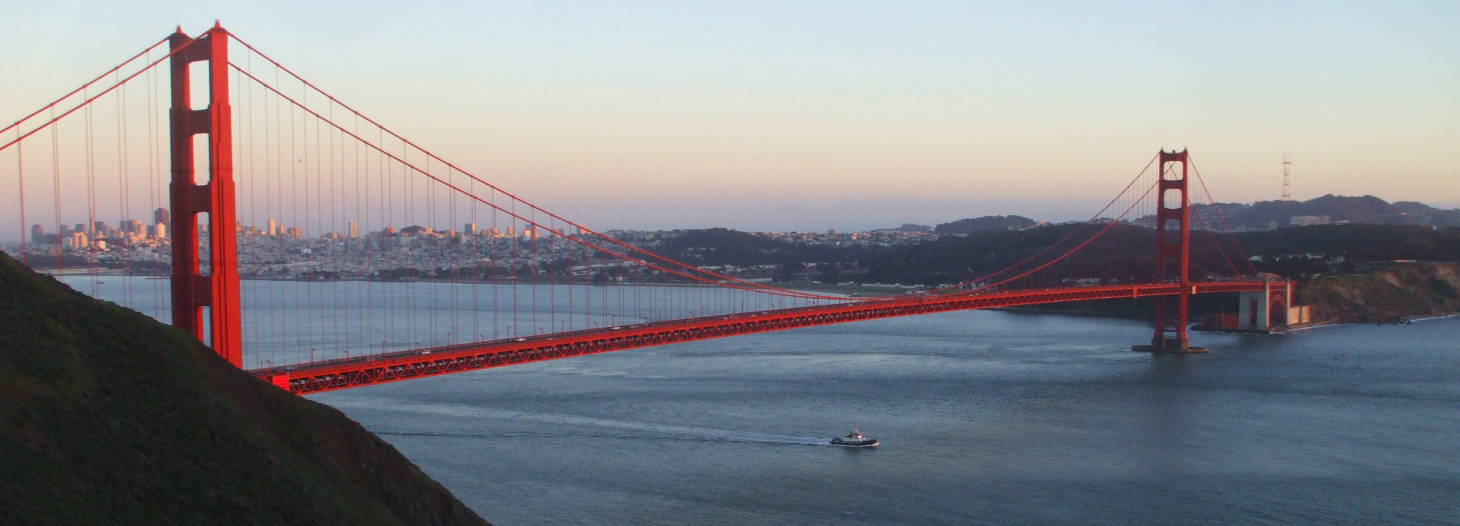
San Francisco
Going to San Francisco
The Golden Gate is an opening 4,200 feet (or 1,280 meters) wide at its narrowest, connecting the large bay system to the Pacific Ocean. The Golden Gate Bridge has spanned it since its completion in 1937, when it was the longest suspension bridge in the world.
San Francisco Bay extends to the south about 30 miles (or 50 km) to the Silicon Valley area. San Pablo Bay is to the north, extending on inland as a large bay and eventually narrowing into the Sacramento and San Joaquin Rivers.

1:250,000 map, 1980, U.S. Geological Survey
The area just north of the Golden Gate is not heavily settled due to the rugged topography, making for some great scenery and parks very close to a large city. Muir Woods and its stand of California Redwoods is just a short drive from the city.
The city of San Francisco itself is famously hilly, much more so than most major cities. The topography has limited the city's growth, resulting in a densely settled area with sharp boundaries rather than the usual ever-growing sprawl.
Amtrak's passenger train service "to San Francisco" is really to the city of Oakland, across the bay. The trains arrive and depart at the Oakland station, buses connect to Amtrak's "station", really a bus station along the Embarcadero waterfront near one end of the San Francisco - Oakland Bay Bridge.
The airport is on a small shelf on the edge of the bay, with little opportunity for expansion beyond further fill to extend the runways.
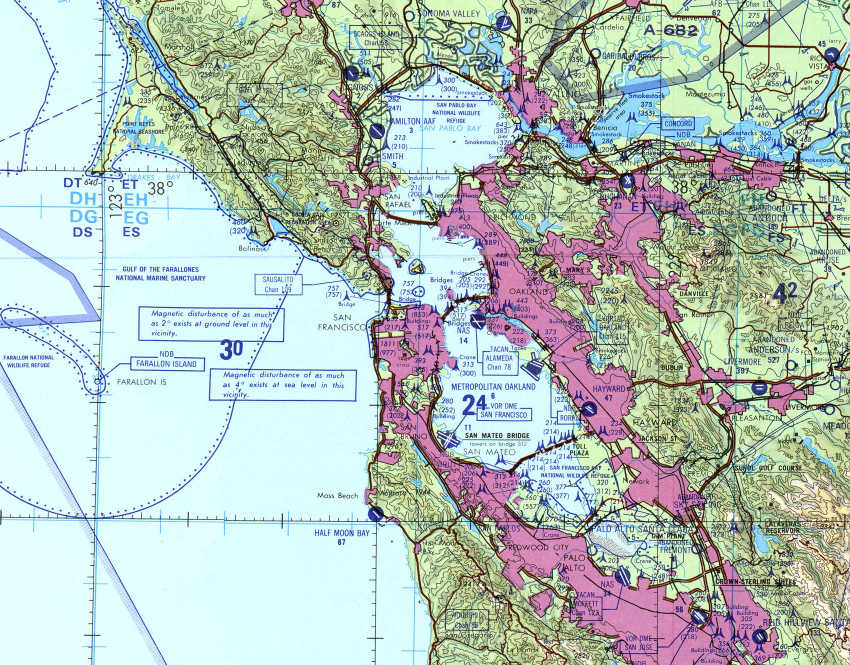
San Francisco Sights

Muni buses 71, 71L, 7 and 6 run from Haight-Ashbury to Market Street. Turn south and walk a few blocks to get to the Mission District. There are many places there with good Mexican food.
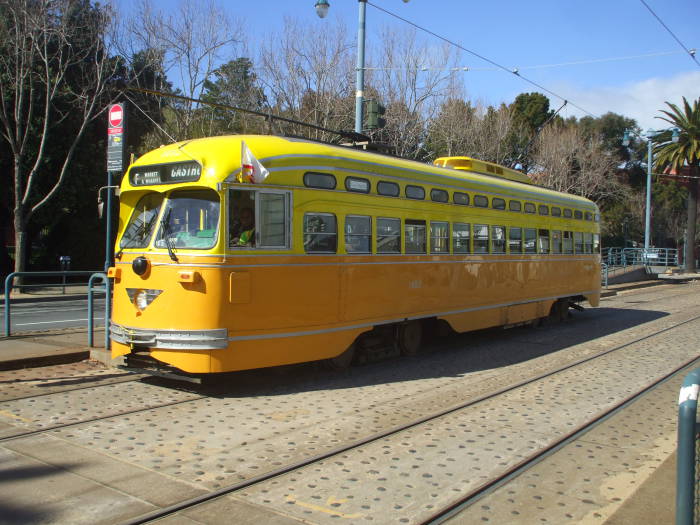
Muni, or, to be formal, the San Francisco Municipal Railway, operates vintage street cars on the F or Market and Wharves line. It runs along Market Street from 17th and Castro, passes the north end of the Mission, continues through downtown, and then turns and follows the Embaracero to the very touristy Fisherman's Wharf area.
Twenty-seven of the vintage streetcars date from 1946-1948 and served in the fleets of Philadelphia and Newark. This bright yellow one is an example of that group.
Another eleven were built in 1928 for Milan, Italy. Five were built for San Francisco in the years 1895-1924. Another ten are from various international cities: Blackpool, England; Hamburg, Germany; Osaka, Japan; Kobe and Hiroshima, Japan; Melbourne, Australia; Moscow, Russia; Porto, Portugal; and Brussels, Belgium.
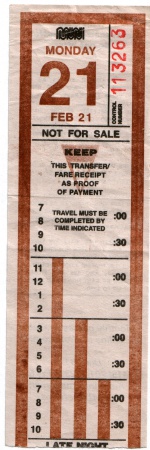
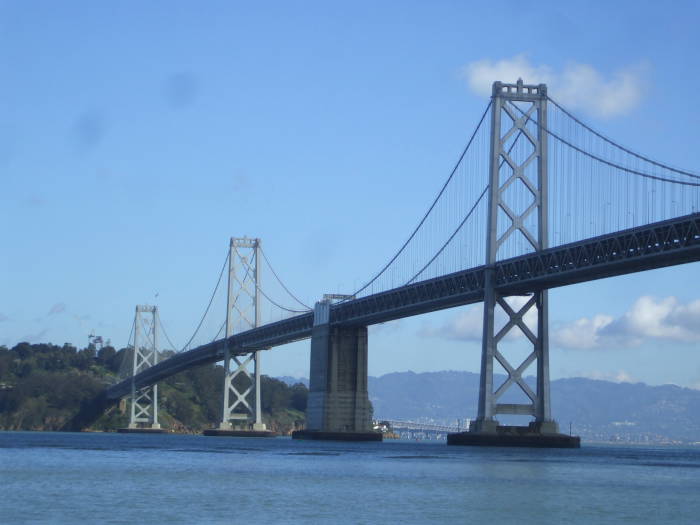
The Embarcadero is the waterfront facing east across the bay toward Oakland and Berkeley. It's also the name of major street running parallel to the waterfront, past the piers. The elevated Embarcadero Freeway was built through there in the 1960s, blocking off the view of the bay. But the freeway was condemned after the "World Series Earthquake" in 1989 and demolished soon afterward. It's now a nice area.
The San Francisco - Oakland Bay Bridge joins those two cities by way of Yerba Buena island. The total length is almost 4.5 miles, a little over 7 km, with nearly equal spans from San Francisco to the island and from the island to Oakland.
The western span, seen here, is a double-decked suspension bridge. The eastern span is a double-decked cantilever bridge and truss causeway. It was opened to traffic in November 1936, six months before the Golden Gate Bridge. The eastern span is currently being replaced.
The large cranes visible at the Port of Oakland inspired George Lucas' vision of the Imperial Walkers in The Empire Strikes Back. More recently, William Gibson's novels Virtual Light (1993), Idoru (1996), and All Tomorrow's Parties (1999) are set in the near future when the Bay Bridge has been converted to a complex home for many people.
The Coit Tower is a decorative tower built on top of Telegraph Hill. The hill's name comes from the large semaphore or "maritime telegraph" built at its peak in 1849. The two-armed semaphore signaled the arrival and nature of the ships entering the Golden Gate. Merchants, wholesalers, and financial speculators used the signals in their businesses. The electrical telegraph system arrived in 1862 and the now obsolete semaphore was dismantled.
We're looking up at Coit Tower from the Embarcadero. The Filbert Steps are a steep staircase leading up from the east, taking the place of Filbert Street which continues west across the city from Telegraph Hill. The staircase runs through an area used as a rock quarry to gather ballast for ships tied up at the nearby piers. The Filbert Steps are straight ahead of us in this view.

Coit Tower was built in 1933. It was a gift to the city from Lillie Hitchcock Coit, a socialite who loved to chase fires. She left one third of her estate to the city "to be expended in an appropriate manner for the purpose of adding to the beauty of the city which I have always loved." It's an Art Deco tower. Its base features murals painted under the Public Works of Art Project, a New Deal employment program during the Depression.
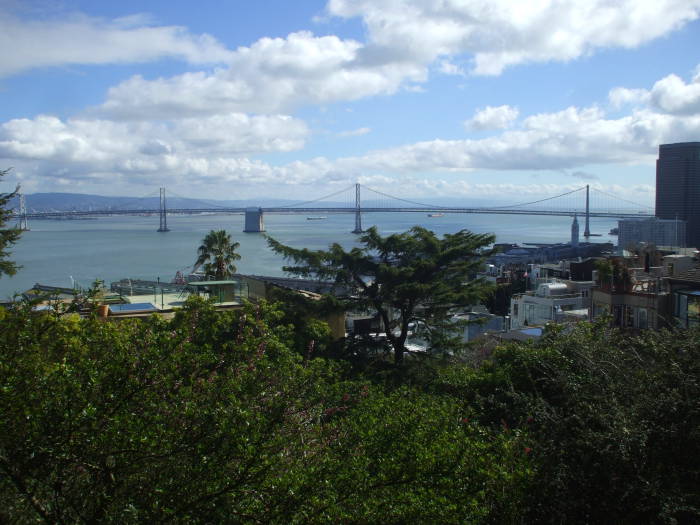
We're nearly at the top of Telegraph Hill, looking back down over the Embarcadero and across the bay. Oakland is beyond the left end of the bridge in this view. Further to the right we're looking all the way down San Francisco Bay to the San Jose area, about thirty miles away.
Alcatraz Island or "The Rock" is a mile and a half north of San Francisco's waterfront.
It was a military installation for many years. In 1861 it was used to house Confederate prisoners of war, beginning its use as a prison. It continued as a military prison after the Civil War. In 1933 is was deactivated as a military prison and transferred to the U.S. Bureau of Prisons. It was a federal penitentiary until 1963.
The theory that always that it was "escape proof" given the cold water and currents in the bay. Officially, there was never an escape. Now the annual Escape from Alcatraz Triathlon begins with a 2.4 km swim from Alcatraz Island to San Francisco, a 29 km bicycle ride, and a 12.8 km run. Recent years have seen 1700 or more participants. So much for the "escape proof" theory.
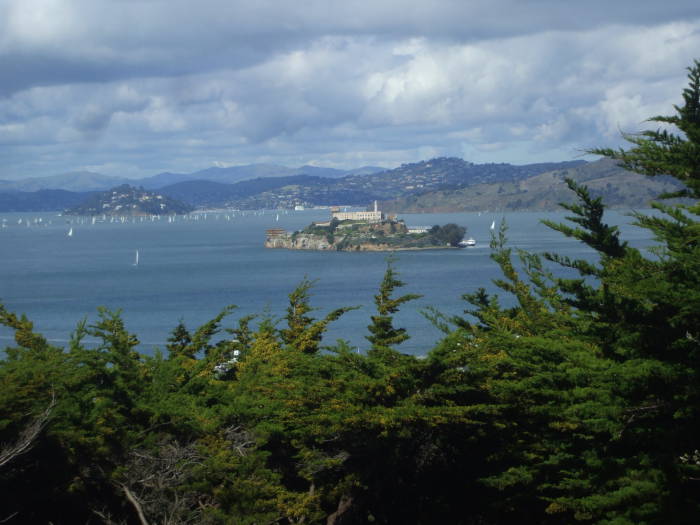
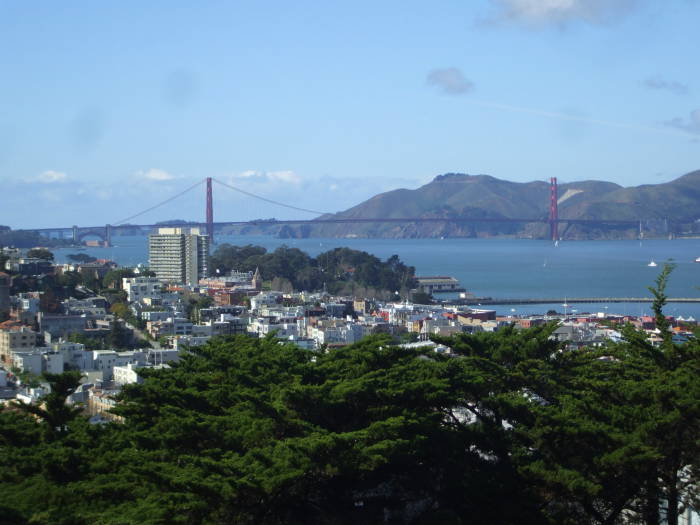
We're looking northwest from Telegraph Hill to the Golden Gate with its famous red-orange suspension bridge. The Marin Headlands are beyond the bridge.
Russian Hill, which we're viewing from Telegraph Hill, was named when Gold Rush era settlers discovered a small Russian cemetery at its top.
The bodies were never identified, but they were probably traders and sailors based at Fort Ross, an old Russian port on the Pacific a short distance north of San Francisco.
Fort Ross — Форт-Росс or originally Крепость Россь — was the hub of Russian America. It was established in 1808 and flourished until the 1830s. The Russian-American Company in Sitka sold it to John Sutter in 1841.

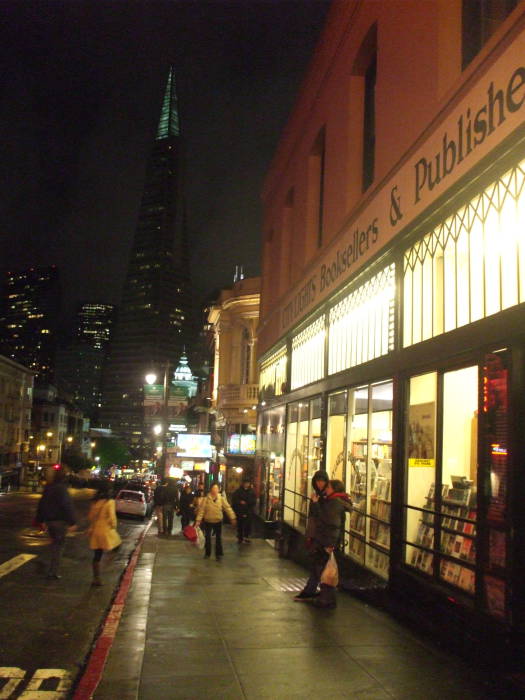
City Lights Bookstore was founded by Lawrence Ferlinghetti and Peter Marin. Ferlinghetti published Allen Ginsberg's book Howl and Other Poems in 1956, leading to his trial for obscenity. He still works in the store.
City Lights is sort of on the boundary between Chinatown and the North Beach area. We're looking down Columbus Avenue past the north end of Chinatown to the Transamerica Tower.
The associated publishing company has published many books by the Beat Generation and others.
If hanging out in Haight-Ashbury and browsing at City Lights got you worked up for a protest, this is the AT&T/SBC facility at 611 Folsom Street, a regional switching center.
This is where the NSA's warrantless surveillance operation ran an intercept facility in room 641A. The room was described in AT&T internal documents as the "Study Group 3 Secure Room". Beam splitters were installed in the fiber optic trunks carrying Internet backbone traffic, and fiber optic lines ran to racks of equipment, including a Narus STA 6400, in room 641A. The Narus unit was designed to intercept, analyze and collect high-speed Internet traffic.

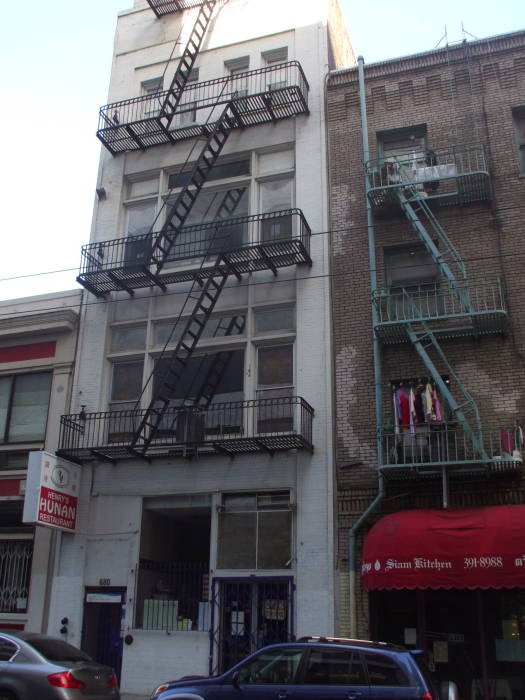
I've stayed a few times at the Pacific Tradewinds hostel, on the edge of Chinatown and easy walking distance to North Beach, the Embarcadero, and Market Street. It's upstairs in the white building seen here. They're at 680 Sacramento Street, +1-415-433-7970, sanfranciscohostel.org.
Another place I've stayed is the Green Tortoise.
A number of places rent bicycles, and it's easy to get to the Golden Gate Bridge.
Through the 1800s and into the early 1900s, San Francisco was the largest American city served primarily via ferries. But the experts mostly said that the two kilometer strait with its strong tides and currents, high winds, and 150 meter depth at its center could not be bridged.
The winning proposal was from Joseph Strauss, "an ambitious but dreamy engineer and poet" who had designed a 55 mile railroad bridge to cross the Bering Strait for his graduate thesis. Given everyone's lack of interest in building such a thing, driven by the complete lack of railroad lines within several hundreds of miles of either end, his practial accomplishments to date had been 400 drawbridges, mostly over inland rivers.
Strauss was made chief engineer for overall design and construction, but engineering and architectural design was left to others.
Charles Alton Ellis was the principal engineer. He was a Greek scholar and mathematician who had been a Univerisity of Illinois professor of engineering despite not having an engineering degree. Strauss fired him in 1931 and replaced him with one of his subordinates. Ellis was obsessed with the project and could find no other work during the Depression, so he continued working up to 70 hours per week without pay, and he eventually submitted ten volumes of hand calculations. He eventually completed a degree in civil engineering from the University of Illinois, and later worked for twelve years at a professor at Purdue University.
Strauss downplayed the work of others and managed to get most of the credit for the design and construction. The record was rectified in 2007, when the formal report on 70 years of stewardship and operation of the bridge gave Ellis credit for most of the bridge's design.
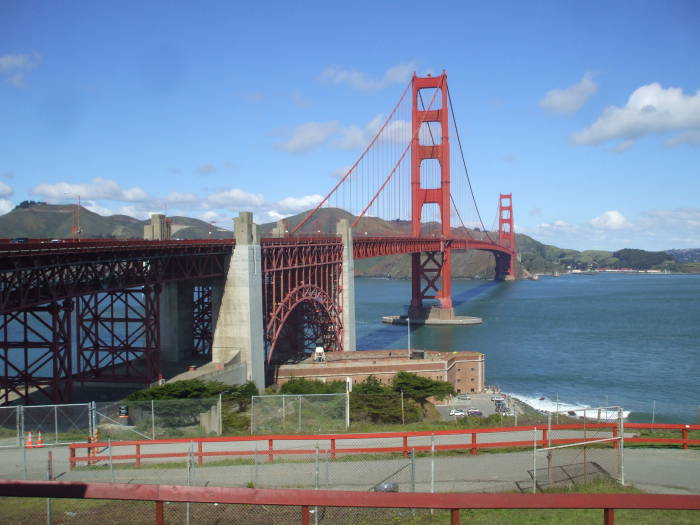

The U.S. Navy wanted it painted in black and yellow stripes for visibility to ships, but the International Orange sealant was kept as the final color.
There are pedestrian and bicycle walkways on either side of the six traffic lanes. Bicyclists can use it 24 hours, pedestrians during daylight hours only.
The Marin Headlands have great views down across the Golden Gate and to the city. The light at sunset is especially nice.
There are a number of large naval gun emplacements and bunkers built starting in the 1890s to prevent hostile ships from entering San Francisco Bay. This was the time of the Spanish-American War and the Russo-Japanese War (or Русско-Японская Война or Nichi-Ro Sensō) of 1894-1905. Further batteries were built into the initial years of World War II.
The area continued to host defensive facilities into the Cold War. SF-88 was a Nike Missile launch site from 1954 to 1974, intended for defense against Soviet bomber aircraft. The Nike-Hercules was a two-stage solid fuel surface to air missile carrying a W7 (2.5-28 kiloton) or W31 (2-20 kiloton) nuclear warhead, or a 770 kg high explosive warhead. It had a range of 90 miles and a flight ceiling of 150,000 feet.